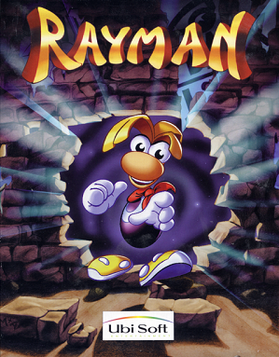
Rayman is a 1995 platform game developed by Ubi Pictures and published by Ubi Soft for MS-DOS, Atari Jaguar, Sega Saturn, and PlayStation. It is the first installment in the Rayman franchise. The player controls Rayman, who must recapture Electoons and the Great Protoon from Mr. Dark. The gameplay involves rescuing Electoons and gaining new abilities throughout the game.
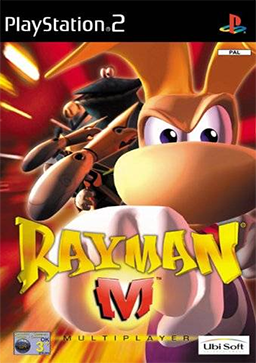
Rayman M, known in North America as Rayman Arena, is a party video game developed and published by Ubisoft. A spin-off of the Rayman series, it features two modes, racing and battle, in which players take control of one of eighteen characters from the Rayman series. The game retains elements from the 1999 platform game Rayman 2: The Great Escape such as, the game's control system.

Rayman 3: Hoodlum Havoc is a 2003 platform game developed and published by Ubisoft, and the third major installment in the Rayman series. It follows Rayman in his quest to stop André from taking over the world with his army of hoodlum soldiers. It was released for the GameCube, PlayStation 2, Xbox and Microsoft Windows, and on OS X by Feral Interactive in 2004. It was also released for the Game Boy Advance, N-Gage and mobile phones as a 2D platformer.

Rayman Raving Rabbids is a 2006 party video game developed and published by Ubisoft. It's a spinoff for the Rayman series and the debut title for the Rabbids franchise. The story follows Rayman as he was interrupted by earthquake in which then he was being kidnapped and forced to played minigames with the Rabbids. The game received generally positive reviews from critics, with some criticizing the minigames either being broken or unenjoyable.
Rayman is a franchise of platform video games, created by video game designer Michel Ancel for Ubisoft. Since the release of the original Rayman game in 1995, the series has produced a total of 45 games across multiple platforms.

Rayman is the title character and main protagonist of the Ubisoft's Rayman series developed by Ubisoft Montpellier. He debuted in 1995 platform game Rayman and is a player character in all the games of the series. He is an anthropomorphic limbless protagonist dressed with a red neckerchief and white gloves with the ability to use his hair as helicopter blades and punch at a distance. He was created by Betilla and her nymph sisters to protect the Glade of Dreams.
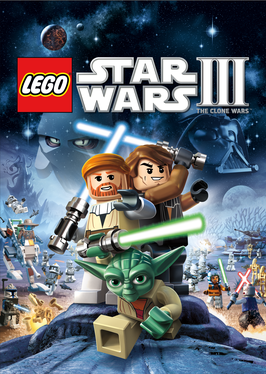
Lego Star Wars III: The Clone Wars is a Lego-themed action-adventure video game developed by Traveller's Tales and published by LucasArts in March 2011 for the PlayStation 3, PlayStation Portable, Xbox 360, Wii, Nintendo DS, Microsoft Windows, and the Nintendo 3DS. It was one of the 3DS's launch titles. The game features missions and characters from the 2008 animated film Star Wars: The Clone Wars and its follow-up television series, as well as fan-favorites from the original Star Wars saga, in both single-player and multiplayer gameplay modes. The Mac OS X version of the game was released by Feral Interactive.

Raving Rabbids: Travel in Time is a party video game developed and published by Ubisoft for the Wii. It was released in North America on November 21, 2010, in Europe on November 26, 2010, in Australia on November 25, 2010 and in Japan on January 27, 2011. It is the fifth installment in the Rabbids series and, unlike the previous entry, Rabbids Go Home, it returns to the party game genre.

Retro City Rampage is an action-adventure game developed by Vblank Entertainment. It is a parody of retro games and 1980s and 1990s pop culture, as well as Grand Theft Auto and similar games. It was first released for PlayStation 3, PlayStation Vita and Microsoft Windows in 2012, with ports later releasing for several other platforms. An enhanced version, Retro City Rampage DX, was released for Nintendo 3DS in 2014, followed by later ports for other platforms. Previous ports of the original version were later updated to the DX version via free updates.

Skylanders: Spyro's Adventure is a 3D action-adventure platform game and the first video game in the Skylanders series. It is played using with toy figures that interact with it through a "Portal of Power" that reads their tag through NFC.
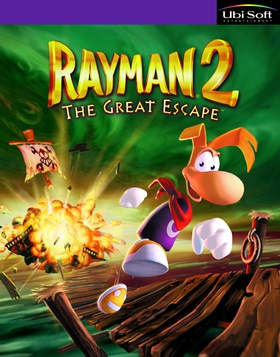
Rayman 2: The Great Escape is a 1999 platform game developed by Ubi Pictures and published by Ubi Soft for the Nintendo 64, Windows, Dreamcast and PlayStation. The game centers on the titular character Rayman, who was tasked with saving his friend Globox and the fantastical land of the Fairy Glade from an army of robotic pirates led by Admiral Razorbeard.
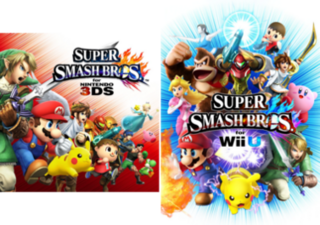
Super Smash Bros. for Nintendo 3DS and Super Smash Bros. for Wii U, both commonly referred together as Super Smash Bros. 4, are 2014 crossover platform fighter video games developed by Bandai Namco Studios and Sora Ltd. and published by Nintendo for the Nintendo 3DS and Wii U video game consoles. It is the fourth installment in the Super Smash Bros. series, succeeding Super Smash Bros. Brawl. The Nintendo 3DS version was released in Japan on September 13, 2014, and in North America, Europe, and Australia the following month. The Wii U version was released in North America, Europe, and Australia in November 2014 and in Japan the following month.
The eighth generation of video game consoles began in 2012, and consists of four home video game consoles: the Wii U released in 2012, the PlayStation 4 family in 2013, the Xbox One family in 2013, and the Nintendo Switch family in 2017.

The Electronic Entertainment Expo 2012 was the 18th E3 held. The event took place at the Los Angeles Convention Center in Los Angeles, California. It began on June 5, 2012, and ended on June 7, 2012, with 45,700 total attendees. It was televised on Spike and streamed online to computers, mobile devices, PlayStation Home and on Xbox Live via IGN's application. This was the last event to be broadcast by G4 along with being the last one to feature a physical press conference by Nintendo which mainly focused on games that were coming to the then upcoming Wii U video game console that launched later that year and was later considered to be a commercial failure.

Rayman Legends is a platform video game developed by Ubisoft Montpellier and published by Ubisoft. It is the fifth main title in the Rayman series and the direct sequel to the 2011 game Rayman Origins. The game was released for Microsoft Windows, PlayStation 3, Xbox 360, Wii U, and PlayStation Vita platforms in August and September 2013. PlayStation 4 and Xbox One versions were released in February 2014, with a Stadia version released in November 2021. A Nintendo Switch port, titled Rayman Legends Definitive Edition, was released in North America, Europe and Australia on September 12, 2017.

MotoHeroz is a platform-racing video game developed and self-published by Ubisoft RedLynx. It was released as a digital download on September 15, 2011 for the Nintendo Wii via its WiiWare service, March 15, 2012 for iOS devices, and September 26, 2013 for Android.

Angry Birds Trilogy is a video game co-developed by Rovio Entertainment, Exient Entertainment, Housemarque, and Fun Labs and published by Activision.

Young Justice: Legacy is an action-adventure video game developed by Freedom Factory Studios and published by Little Orbit. It was released in November 2013 for Nintendo 3DS, Microsoft Windows, PlayStation 3, and Xbox 360. The game is based on the Young Justice animated television series, and takes place in the five-year gap between seasons one and two, and was developed in collaboration with the writers of the series, Greg Weisman and Brandon Vietti. Originally the game was planned to also be released on Nintendo DS, Wii, and Wii U, but the developers announced that these versions were cancelled due to quality issues and low interest from retailers.

















